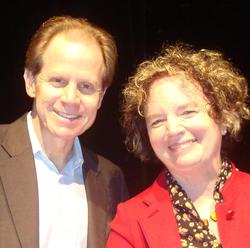 Only 55% of us have “secure attachment,” which would worry us all if we knew what it meant, according to research on over 2,000 infant-parent pairs.
Only 55% of us have “secure attachment,” which would worry us all if we knew what it meant, according to research on over 2,000 infant-parent pairs.
The math says the other 45% of us suffer “insecure attachment.” That means 45% can’t handle a committed, stable relationship with anyone, from childhood to the rest of our lives, as of 1996. We also pass this emotional pain to our children, who turn out similarly. A National Institute of Health article summarizes the secure rate: “Infants with secure attachment greet and/or approach the caregiver and maintain contact but are able to return to play, which occurs in 55% of the general population.” [FN1]
This is the blockbuster result of Dr. Mary Ainsworth’s 1970-1978 “Strange Situation” study of babies (Part 1 of this blog). The work was completed by her student Mary Main (Part 2 coming Feb. 6), and Main’s research led to shocking conclusions. (Dr. Main with Dr. Daniel Siegel, above)
Main discovered so many babies were peculiar, she got concerned about the parents. So in 1982 she created the Adult Attachment Interview (AAI) to study the adults, releasing results 1984-96.
Her journey was so “Strange” and involved, that it got published in language hard to decipher (or even google) for most folks. The tale took me weeks to unravel (footnotes below).
This huge “insecure” figure is a predictor of broken homes and broken hearts for half the nation. It starts to explain why we’ve got a 50% divorce rate. If you’re like me and have tried “over 40” internet dating after a divorce, it won’t surprise you to hear that science shows 50% of adults out there can’t carry on a secure, committed, loving relationship. You’ve already experienced it.
And if 45% of us were “insecurely attached” in 1996, what’s the percent in 2014? In 1996 most of us hadn’t heard of the Internet. In almost 20 years since, email, texting, and so on have further trashed our ability to relate in person. Several psychotherapists interviewed for this blog said that a round number of “about 50%” is a conservative estimate for how many Americans lack secure attachment today. Many believe it’s much higher.
We can heal. If we didn’t get securely attached as kids, we can develop “earned secure attachment.” “It’s possible to change attachment patterns,” Dr. Main says in a 2010 video. [FN5]
Strange Situation Experiment
Attachment Theory isn’t new, it just gets too little air time. British psychiatrist John Bowlby (left) developed it in the 1950s while dealing with the post-WWII crisis of dislocated orphans. [FN6] Bowlby reasoned that all infants would seek to stay close to parents, since “proximity-seeking behavior” (attachment) is best for survival, so it’s bred into us by evolution. In 1952 he published a study of toddlers’ responses to major separations from parents. It showed that “when toddlers were placed in unfamiliar surroundings that provided no stable caregivers, they underwent three increasingly unfavorable stages of response to separation: protest, despair, and finally detachment.” [FN7]
Dr. Mary Ainsworth studied with Bowlby in London 1950-54, then studied this same “proximity-seeking behavior” (attachment) in infant-mother pairs in homes in Kampala, Uganda, published as “Infancy in Uganda” (1967). Next, she “found astonishing similarities in homes in Baltimore, Maryland (Ainsworth et al. 1978).” [op cit FN7]
So Ainsworth created the Strange Situation in the early 1970s, as a science experiment at Johns Hopkins in Baltimore to document this infant behavior. “Ainsworth deliberately structured the Strange Situation to include three of Bowlby’s ‘natural clues to danger’… to arouse babies to seek proximity” to the parent, Main says. Researchers watch and video-tape through one-way glass, as infant-mother pairs react to apparent danger. First the babies respond to the strange lab room; then to two entrances of a stranger into the space; and separation from mother at two different times. [FN8]
In the Strange Situation, all or most babies were expected to stay close to parents as Bowlby thought. Such babies, “that Ainsworth termed ‘secure,’ play and explore happily prior to separation; show signs of missing the parent during separation, such as crying and calling; seek proximity immediately upon the parent’s return; and then return to play and exploration, ‘secure’ once again in the parent’s presence,” said Main. [op cit FN8]
But 30% of babies did not act secure — they avoided mom.....
READ MORE: Here's the original research, unraveled and made clear for the first time: http://attachmentdisorderheali...view-aai-mary-main1/



Comments (2)